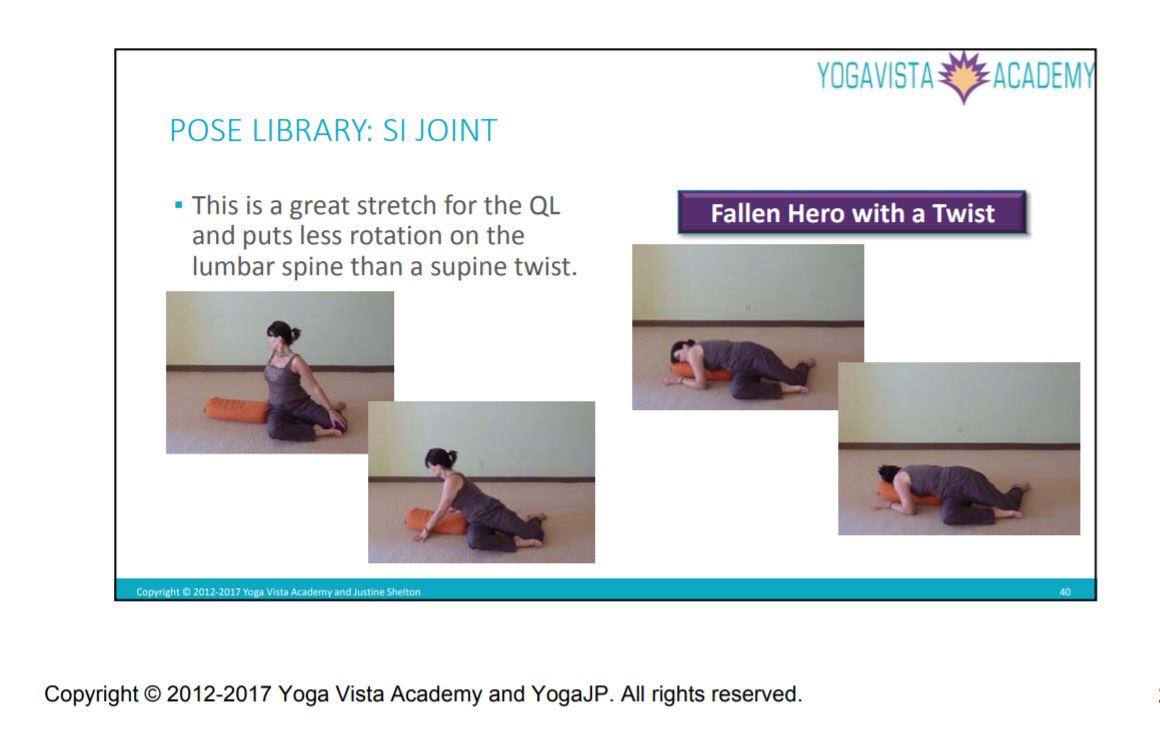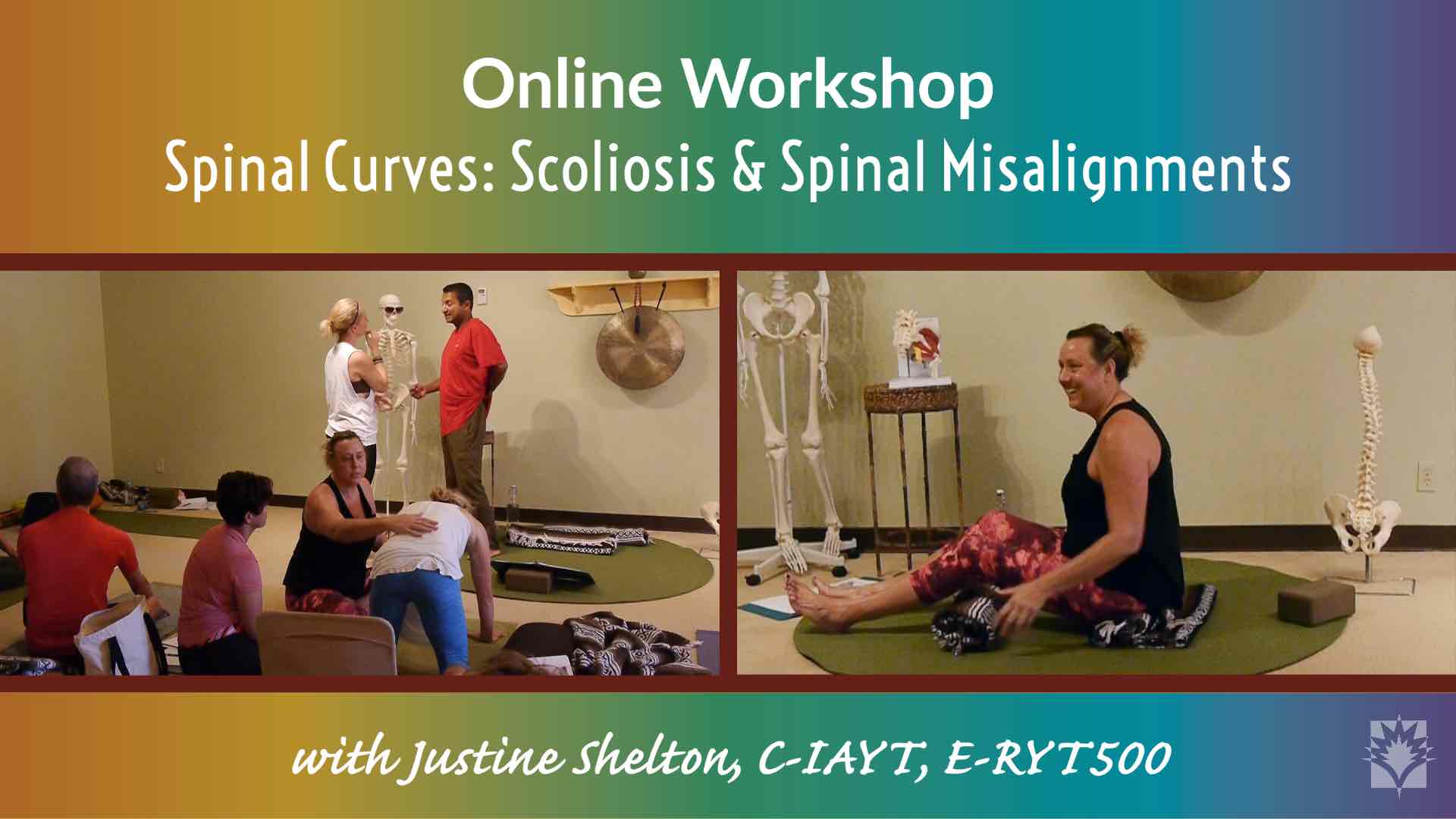Is it Safe for a Student with Scoliosis to Twist?
Is it Safe for a Student with Scoliosis to Twist?
Leslee’s favorite twist (Justine’s too!!)

Answer from Justine
I have to start the answer here with, it depends! Is the scoliosis an S curve or C curve? If it is a C curve, is it in the thoracic or lumbar spine?
Lumbar Disc Damage or SI Joint Dysfunction with Scoliosis
Are there any other co-conditions such as SI joint dysfunction or Lumbar disc damage? These will complicate the condition and add a whole new list of contraindications.
IF there is lumbar disc damage, the combination of flexion with rotation while the hips are fixed (ie in the chair) is risky and could further damage the disc – if this is the case, have the person stay seated with the spine tall and do the twist using just core strength to rotate the axis of the spine.
If there is SI joint dysfunction, and it is acute, then the same precautions apply. If it is not acute, keep the knees hip width apart to stabilize the SI joints (possibly squeezing a block between the thighs) and limit the flexion of the spine by placing a block on the floor to bring the ground closer. Make sure the students doesn’t use the floor/ground for leverage – twists should be deepened with core strength, not leverage (this is true for all of us!!)
If the scoliosis is stand alone, meaning there aren’t other conditions complicating the issue, twists can be very helpful in balancing out the asymmetry in the musculature on each side of the spine. That being said, ALWAYS let pain be the guide for the student – meaning, if pain is created come out – it is not worth the risk! No pain, no pain!
Best Yoga Poses for Scoliosis
Axial extension and asymmetrical poses are great for working with scoliosis – axial extension being creating as much space in the spine from tailbone through the crown of the head – lengthening the axis of the spine. Asymmetrical poses work each side of the body independently, so the strong side doesn’t ‘take over’ for the weak side. That being said, asymmetrical poses including the legs (ie standing head to knee pose, Warrior I, etc.) put sheer stress on the sacrum and are contraindicated for SI joint dysfunction.
However, standing in tadasana with one arm raised by the ear, on exhale going into uttanasana and on inhale rising (keeping the arm in line with the ear), repeating several times before holding the forward fold, will strengthen each side of the upper back independently while also working with the bio-mechanics of movement for the practitioner, then the hold allows for stretching the musculature more deeply.
It is important to know that what works for one person with scoliosis my not work at all for another. This condition manifests very differently in people, so there is no ‘one size fits all’ pose or practice for dealing with it. Be in congress and communication with your student – the more they tell you how things feel, the better you understand their body and how to serve them with Yoga. I love my students and clients, they are my greatest teachers!
From Leslee R., Gentle Yoga Teacher who has Scoliosis
I am happy to give my input but would definitely say first and foremost that every persons’ experience and reaction to various poses will be different with or without scoliosis. The seated sun salutation feels wonderful to me and I have no discomfort with the side twisting movement. As a matter of fact, it feels really great! I am also comfortable doing the modified sun salutation standing as long as I keep my knees bent generously.
I am able to do most poses but may need to modify some of them. Poses that create discomfort or pain in my body are:
Modified Yoga Poses for Scoliosis
1.) half moon on the floor but I can do it standing
2.) twists lying on my back create pain on my left side ( my scoliosis in the lumbar rotates to the right) in my psoas and/or QL. My favorite twist for my body is the reclining twist on a bolster. This is very yummy to me and I really relax and release in this twist. I am also comfortable doing a gentle seated twist.
3.) Lunges are also not my favorite but with the modification of keeping the knee down and using blocks I am able to benefit without discomfort.
Pose that feel good and help my back if I overdo and create muscle tension or spasm are:
1.) Pelvic tilt
2.) Apanasana forward and back and circular
3.) Butterfly
4.) Supported Inversion on a bolster
5.) Tree pose
6.) Windshield wiping my legs while lying on my back, feet mat width apart
7.) Cat/Cow on hands and knees and also seated
8.) Lateral stretch over a bolster
9.) Child’s Pose with knees wide and arms at my sides
10.) Savasana with a bolster under my knees
I have an S curve scoliosis so the rotation is both in my thoracic and lumbar spine. As I said earlier, depending on the type of scoliosis and the degree of the rotation each persons’ reaction and experience to poses will vary.
I am exploring the side plank after reading the following article:
https://www.yogainternational.com/article/view/yoga-for-scoliosis-new-research-supports-the-benefits-of-side-plank1
It’s a tough pose for me and I am not yet able to do the full extension of the pose. I do it against the wall on my forearm instead of my hand and my top leg is bent on the floor for support instead of resting on the bottom leg. (Hope this is clear) There is a lot of controversy about whether this really helps or not and whether to do it on the convex, concave or both sides. I do it on both but hold it for a longer time on the concave side.
I also incorporate somatics into my practice which I find beneficial.
Hope this is helpful.
Much love,
Leslee
Related Online Workshop
Online Workshop: Spinal Curves: Scoliosis and Spinal Misalignment
Our spinal curves are there for a reason – they help balance weight distribution throughout the spine. However, in some people, the curves are either too much or too little. Yoga helps with balancing these spinal curves for optimal function in the body. With the aging body comes gravitational forces that can affect our physical structure, and repetitive use samskaras that can negatively affect our posture.
This workshop will take an in-depth look at spinal kyphosis and lordosis, flattened thoracic curve as well as scoliosis. Justine will cover key aspects of spinal anatomy and how Yoga can specifically aid in balancing these curves.


